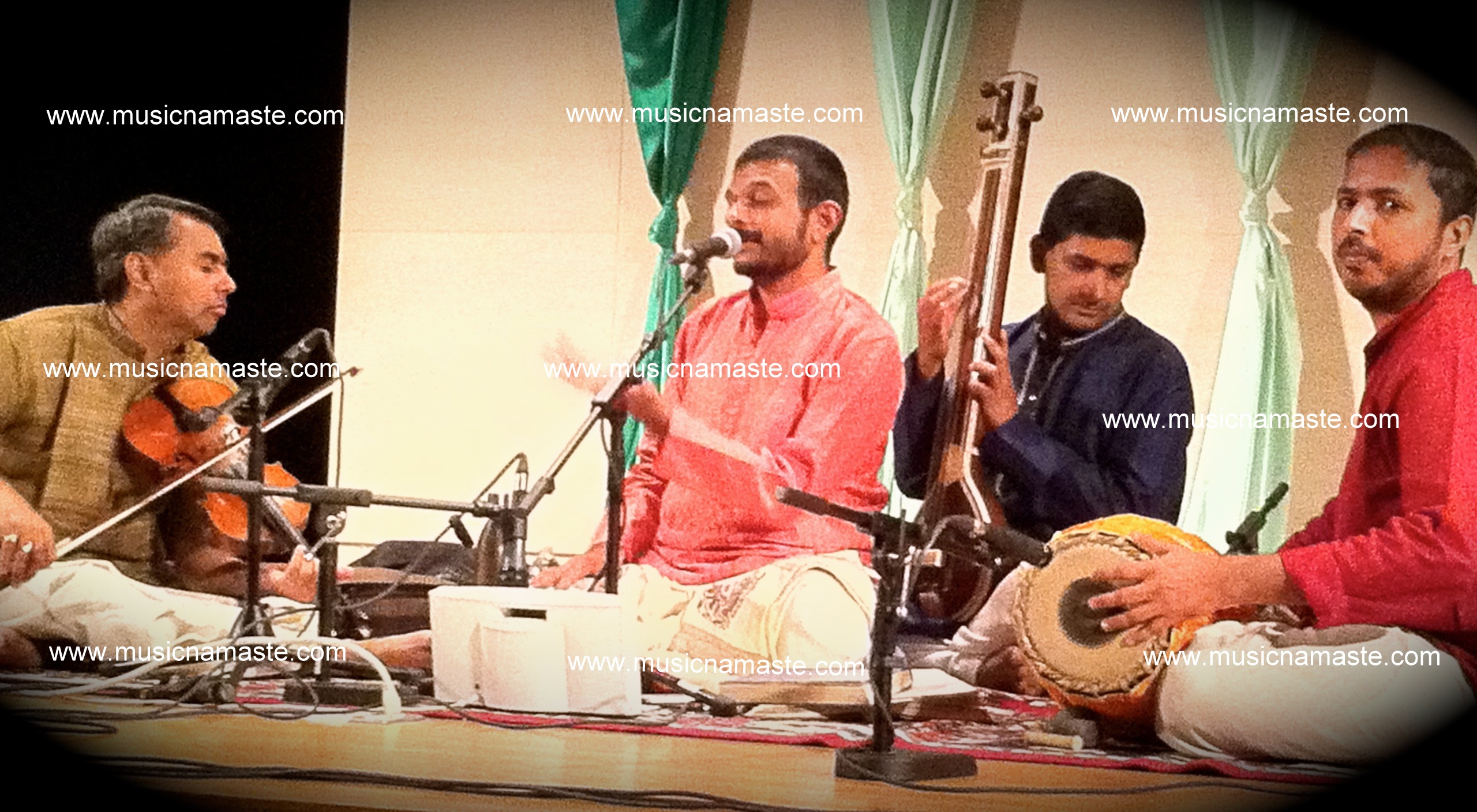I had the immense pleasure of attending a concert by Sri.T.M.Krishna. And Oh My, what a spiritual journey it was for me! Let me get into the details of the concert and make a humble attempt to explain.
Sri. T.M Krishna was accompanied by K.Shriram Kumar on Violin and Arun Prakash on “Mridangam”
Sri.T.M.Krishna began the concert with the “Kriti” “Raama Nee Pai” by composer Tyagaraja. I have listened to many musicians sing, but this was so different as it was so rich with “Bhava”. The pattern – “Sa – Ma – Ga – Ma” seemed so beautiful. It appeared to me that the “Swaras” had taken the form a river flowing gently around islands, and nourishing and nurturing as it moves along.

Sri. T.M.Krishna in Concert
The next composition was “Ananda Amritavarshini” set in “Raaga Amritavarshini”. It was a Muthuswami Dikshitar composition. Before beginning the song Sri.T.M.Krishna joked that if it rained now, it was because of nature and not because of his singing. “Raaga Amritavarshini” is believed to bring rains.
The next composition was in “Raaga Sahana”. The prelude to this was the discussion about “Raaga Sahana”. TM Krishna explained that the “Raaga Sahana” that he is going to sing is the older version of “Raaga Sahana” that was popular in the Muthuswami Dikshitar times. The current “Sahana” has only “Antara Gandhara”. But the old “Raaga Sahana” has both “Sadharana Gandhara” and “Antara Gandhara”. “Antara Gandhaara” is like a “Anya Swara” ( foreign note ). Due to the presence of “Sadharana Gandhaara”, “Antara Gandhaara” seems all the more vibrant. The “kriti” was “Eeshanadi Shiva” by Muthiswami Dikshitar.
The next “kriti” was “Nijamathulanu Telisinavaali”
There were two “Pallavis” rendered in the concert which was a definite treat. One of goes like “ Shankari Madhura Vani Bhaje Narapati Kishori” . Sri.T.M.Krishna explained that this was a special composition specifically created for the 80th birthday celebrations of Kishoriji held in Pune. It was composed by the violin artist of the moment – K Shriram Kumar.
This was truly musical masterpiece, where in violin maestro and the vocal maestro challenged each other playfully. I started noting down the “Raagas” elaborated – “Sindhu Bhairavi”, “Shubha Pantuvarali”, “Kalyani”, “Kambhodi”, “Kadana Kutoohalam” and I lost track after a while. They were so skilled that “Raagas” were changed so quickly and masterfully.
The concert also included songs like “Padavini”, “Shree Ramachandra” ( “ Raaga Yaman Kalyani” ), “Rama Jana Dhana”, “Srinivasa Venkata” ( “Raaga Hamsanandi” ) and “Narayana Hari”. All of them were so mellifluous.
There are three things that touched me about Sri.T.M.Krishna. First one was his style of singing. It is definitely lovely traditional. In fact the whole stage looked very traditional in the traditional attire of the artists.
The second important aspect is that his singing seemed so free even though he is within the boundaries set by Carnatic music. It is a true example and an inspiration to purists that joy of music and the freedom can be achieved inside the framework too.
The third significant aspect that makes his singing so unique is his voice coupled with his style of singing. Who says that Carnatic music has to be loud and that you have to sing at high volumes? Sri.T.M.Krishna so masterfully created dips and highs in his voice to produce an amazing result – a “bhava” filled classical melody. Sitting there at the front row, I felt like his voice was like the ocean, which at times seems so calming and soothing. But at times, it can also roar with aggression.
To match this amazing style of singing, the “mridangam” player has to be very capable. Where should the “mridangam” walk side by side, where should it completely stop and where should it show its full grandeur, these nuisances where wonderfully understood by Arun Prakash.
The violin artist is a master in himself. He not only emulated Sri.T.M.Krishna ‘s notes to the minutest detail, but also challenged him with complex “swara” patterns.
I felt truly blessed to have witnessed this concert. MusicNamaste wishes TM Krishna all the very best!
